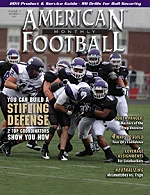AMERICAN FOOTBALL MONTHLY THE #1 RESOURCE FOR FOOTBALL COACHES
|
|
Article Categories
|
Drills Report: Running Back Drills for Ensuring Ball Securityby: Eric DavisFormer Running Backs Coach, Minnesota State University © More from this issueWe ask a great deal of our running backs at Minnesota State University, and it is my job as running backs coach to help our players meet the expectations we have of them. Some of our offensive game goals that our RBs are directly involved in include:
• 100% Ball Security.
• Break 25 tackles as a team and gain more than 75 yards after contact.
• More than 90% positive plays and more than 10 explosive plays.
• Out-rush our opponents in the fourth quarter.
Practice time is a very precious commodity, and every drill should serve a purpose. I think it is good to periodically revisit every individual, group, and team drill you do in order to make sure it fits into what you are trying to achieve as a team. I haven’t invented any drills, but I have taken what I have seen v....The full article can only be seen by subscribers.
Subscribe today!

|
|
|
NOT A SUBSCRIBER?
Subscribe
now to start receiving our monthly magazine PLUS get INSTANT
unlimited access to over 4000 pages of 100 percent football coaching
information, ONLY available at AmericanFootballMonthly.com!
|
|
|
HOME
|
MAGAZINE
|
SUBSCRIBE
|
ONLINE COLUMNISTS
|
COACHING VIDEOS
|
Copyright 2025, AmericanFootballMonthly.com
All Rights Reserved






